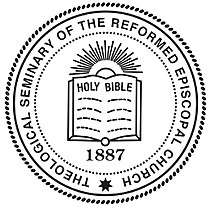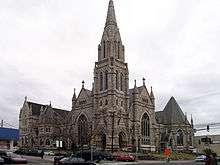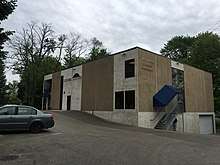Reformed Episcopal Seminary
The Reformed Episcopal Seminary is a Reformed Episcopal theological seminary in Blue Bell, Pennsylvania. It was founded in 1887 as the first seminary of the Reformed Episcopal Church.
The Theological Seminary of the Reformed Episcopal Church | |
 | |
| Motto | We are ambitious to be well-pleasing unto Him |
|---|---|
| Type | Theological seminary |
| Established | 1887 |
Religious affiliation | Reformed Episcopal Church |
| President | Jonathan S. Riches |
| Dean | Jonathan S. Riches |
Academic staff | 8 |
Administrative staff | 6 |
| Students | 23 |
| Location | , , United States |
| Colors | Grey, blue |
| Affiliations | Theological Commission of the Reformed Episcopal Church, Association of Theological Schools, Anglican Church in North America |
| Website | reseminary.edu |

History


The Reformed Episcopal Seminary was founded in 1887 in West Philadelphia, Pennsylvania, as the "Theological Seminary of the Reformed Episcopal Church", its chartered and legal name. The seminary was established based on the pledge of a trust created by Harriet Benson in March, 1886.[1] The corner stone for the first building to house the seminary was laid on September 19 of that same year.[1] The seminary began meeting for classes in 1886 under the tutelage of Bishop William Nicholson in his residence. It officially opened the doors to its first class of students on September 30, 1887, in its new building in West Philadelphia, Pennsylvania, as the seminary of the Reformed Episcopal Church, after the trust was received on March 16, 1887.[2]
The Reformed Episcopal Seminary upholds the doctrinal statement adopted by the Reformed Episcopal Church. Two documents comprise the doctrinal statement: the Thirty-Nine Articles, and the Declaration of Principles.[3] The term "Reformed" has various meanings within larger Christian community. For example, Presbyterians have expressed the reformed faith in the Westminster Confession of Faith, while Reformed Baptists have commonly expressed the reformed faith in the 1689 London Baptist Confession of Faith. The Reformed Episcopal Church was founded on the Thirty-Nine Articles as they express a summary of the necessary doctrines that brought about reformation in the Church of England. While later statements of faith have expanded and added to the doctrines expressed in the Articles, the Thirty-Nine Articles represent the necessary doctrine that defines the Protestant position against the Roman Catholic position of that period, and in unity with the reformations taking place elsewhere in Europe.
"Once in the early days our Church was referred to as the "Primitive Episcopal Church," and the name seems to fit its mission. The word "Primitive" shows that it is a restoration, going back not only to the days of our country's early history, but back to the Reformation, when the fires of martyrdom and the horrors of torture could not drive away from the truth those who held it in their keeping; back still farther to the days of the apostles; aye back farther yet, to the teaching of Him who, beside the blue waters of Galilee, called followers into His service, that He might make them "fishers of men."[4]
Academics
The seminary educates and trains Christians for lay and ordained ministries. It emphasizes a strong commitment to belief in the inerrancy of the Bible as the word of God, adherence to reformed theology and evangelical beliefs, worship and polity in the Anglican tradition, and pastoral ministry training.[5] The seminary offers a Master of Divinity (MDiv) degree program, a diploma program, two certificate programs, as well as a licentiate for diaconal minister program or deaconess ministry. It is on the quarter system and is academically rigorous, requiring the completion of 150 credits for the master's degree.[5]
In 2015 the school initiated an Honors Thesis program for select MDiv students. High achieving students are invited by the faculty to write a Thesis in their senior year which they are required to defend before a panel of faculty members.
Mission
The charter of the seminary states that it was formed “for the purpose of educating and training men for the ministry of the Gospel of our Lord Jesus Christ especially in connection with the Reformed Episcopal Church and in accordance with the Constitution, Canons, rules, regulations, principles, Doctrine, and worship of said Church.” Its mission statement declares that it seeks "to train Christ’s people to serve the flock of the Lord Jesus Christ through biblical, Anglican Worship, Example, and Discipleship as defined in the official standards of the Reformed Episcopal Church... and to immerse students in Scripture, the historical and ancient traditions of the church, worship, and doctrine." The seminary emphasizes what they describe as "classical Anglicanism lived out in the world through worship, evangelism, and discipleship."[6]
The seminary further describes itself as Evangelical, Catholic, Reformed, Ecumenical and Episcopal, defining the terms this way:
- Evangelical - proclaiming Jesus Christ as Savior and Lord;
- Catholic - affirming the faith of the apostles as expressed through the early creeds and liturgy;
- Reformed - holding the English Reformation doctrines of the primacy of Scripture and justification by grace through faith;
- Ecumenical - welcoming students from a variety of church groups and backgrounds;
- Episcopal - holding to the worship, doctrine, and order of the English Reformation.[7]
Location
The seminary's first location was at the corner of 43rd and Chestnut streets in West Philadelphia alongside the magnificent Christ Memorial Church (pictured at right.) Currently the seminary is in Blue Bell, Pennsylvania, a suburb of Philadelphia. It consists of three buildings, including one dorm house for students. Also resident on campus are the offices of the Reformed Episcopal diocese of the Northeast and Mid-Atlantic and its Committee on Young People's Work.
Student body
As of 2018, the Seminary has 21 students enrolled in their ministerial degree program.[8]
The student body of the seminary is racially diverse and ecumenical. Students come from a variety of traditions, including: African Methodist Episcopal, Anglican, Assemblies of God, Baptist, Church of God, Congregational, Lutheran, and Presbyterian. While celebrating diversity and teaching students in regard to a variety of perspectives, the institution's principal purpose is to prepare leaders, clergy, counselors, educators, missionaries, and laity for service within the Reformed Episcopal Church and the Anglican Church in North America. The curriculum therefore, is formed to assist students in their desired ministerial and scholastic goals and to be grounded in Anglican polity and worship.
The seminary trains clergy candidates for the Reformed Episcopal Church, the Anglican Church in North America, as well as other churches traditions. Currently the majority of the Seminary's clergy candidates are Anglican. Clergy are educated in the Bible as the ultimate rule in faith and practice and about the historic faith as handed down in the creeds and historic confessions such as the Thirty-Nine Articles of Religion.
Accreditation
The seminary was granted initial accreditation by the Association of Theological Schools in the United States and Canada, effective August 8, 2013.[8] The Theological Commission of the Reformed Episcopal Church and the Anglican Church in North America have also both approved the Reformed Episcopal Seminary.
Administration
Until 1982, the chief institutional officer of the seminary was the Dean. Since then the primary institutional officers have been the President and the Dean.[9]
| Dean | Years | President | Years |
|---|---|---|---|
| The Rt. Rev. William Nicholson | 1886-1901 | ||
| J. Howard-Smith | 1901-1903 | ||
| Joseph Dawson Wilson ( Chairman of the Faculty) | 1903-1924 | ||
| The Rt. Rev. Robert L. Rudolph | 1924-1930 | ||
| The Rt. Rev. Robert Westly Peach | 1930-1936 | Milton C. Fisher | 1975-1982 |
| George Handy Wailes | 1936-1959 | The Rt. Rev. Leonard W. Riches, Sr. | 1982-1990 |
| Fred C. Kuehner | 1959-1975 | David E. Schroeder | 1990-1991 |
| Milton C. Fisher | 1975-1987 | Ray R. Sutton | 1991-1995 |
| Allen C. Guelzo | 1987-1991 | The Most Rev. Leonard W. Riches, Sr. | 1995-1998 |
| David P. Kletzing | 1991-1996 | Wayne A. Headman | 1998-2009 |
| Jon W. Abboud | 1997-2012 | The Rt. Rev. David L. Hicks | 2009-2019 |
| Jonathan S. Riches | 2012–Present | Jonathan S. Riches | 2019–Present |
Notable alumni
- Milton C. Fisher – 1948 Bachelor of Divinity, dean, president, and Professor of Old Testament at Reformed Episcopal Seminary, NIV Bible Translation Committee member[10]
- Roy A. Clouser – 1962 Bachelor of Divinity, author and professor emeritus at The College of New Jersey[11]
- Samuel Baraga – 1974 Master of Divinity, director, Bharat Bible College, Dabilpur India[12]
See also
References
- Acker, Raymond A. A History of the Reformed Episcopal Seminary: 1886-1964, p. 12
- Guelzo, Allen C. For the Union of Evangelical Christendom. p. 284
- "Reformed Episcopal Seminary: Our Faith".
- Price, Annie Darling (1902). History of the Reformed Episcopal Church. Philadelphia, PA: James M. Armstrong. pp. 208–209.
- "Anglican Education : Reformed Episcopal Seminary". Reseminary.edu. Retrieved 2016-08-19.
- "Student Handbook" (PDF). Reseminary.edu. Retrieved 9 August 2014.
- "Reformed Episcopal Seminary: Heritage and Purpose". Resimnary.edu. Retrieved 2016-08-19.
- "member schools: Reformed Episcopal Seminary". Association of Theological Schools. Retrieved 19 Dec 2013.
- "Seminary Archives".
- "The Rev. Dr. Milton C. Fisher". LancasterOnline. Retrieved 2018-05-22.
- "Roy A. Clouser | Philosophy, Religion, and Classical Studies". philos.tcnj.edu. Retrieved 2018-05-22.
- Giri. "BHARAT BIBLE COLLEGE". bharatbible.org. Retrieved 2018-05-22.